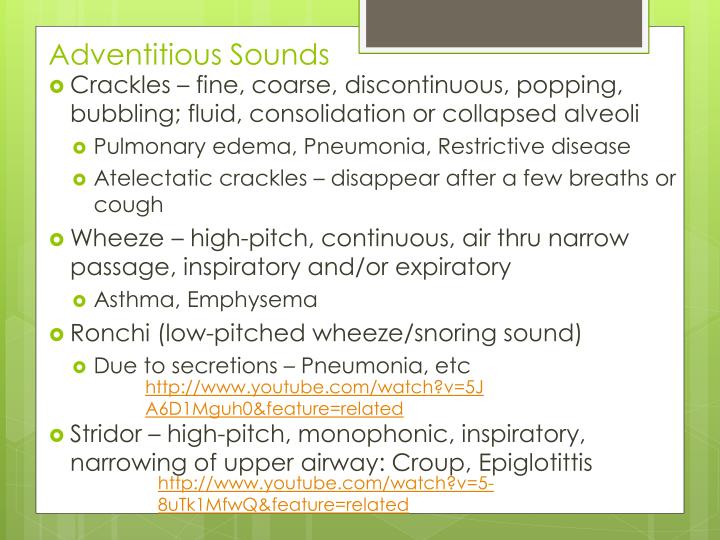

This sound is an indication of pleural inflammation and it’s like two pieces of leather or sandpaper rubbing together.You might also be interested in our collection of 900+ OSCE Stations, including a range of respiratory examination stations. Pleural rub sound auscultated at the level of lower lateral chest areas and occurs with each inspiration and expiration. Some researchers or clinicians still use the term rales.Ĭrackle sounds can be heard in the following conditions:

Crackles are associated with obstructive respiratory disorders and may result from sudden opening or closing of airways or due to any movement in secretions during inspiration and expiration. It sounds like brief bursts of popping bubbles and is commonly heard during inspiration. The crackles are discontinuous adventitious sounds. Other causes include allergies, bronchitis, emphysema or pneumonia.ĭuring bronchodilator treatment, these wheezes diminished or change in pitch. There are two main causes of wheezing including lung diseases e.g COPD and asthma. bronchospasm or when secretions are narrowing the airways. They are most common during expiration, and related to airways obstruction i.e. But ATS-ACCP recommends referring to all continuous adventitious sounds as wheezes and specifying whether they The term rhonchi as low pitch adventitious sound still commend by some researchers. Wheeze is continuous adventitious lung sound, with constant pitch and varying duration. There are 2 types of adventitious sounds:įurther Divisions of adventitious breath sounds Wheeze and Rhonchi How these normal lung sounds produced?: through turbulence of airflow in airways. It can also be heard posteriorly between two scapulas.

These bronchovesicular sounds are actually softer version of bronchial sound. The third one is bronchovesicular which is normal breath sound heard over the junction of mainstem bronchi with segment bronchi. The bronchial breath sounds (tubular sounds) are loud and high pitched sounds. There are also different breath sounds which are normal and auscultated at different points like at tracheobronchial tree. In normal sound, expiration is shorter and quieter than inspiration These are soft and low pitch sounds which heard primarily during inspiration, prominent at top of lungs and centrally

It occurs when vocal cords vibrate during inhalation and exhalation. Lung Soundsįirstly, knowing about lung sounds helps to improve observational skills. With this auscultation process, the abnormal sounds like wheezes, crackles or the areas of consolidation can be easily identified. If auscultation sounds are very faint or distant, then recheck the sounds again by reminding the patient to take deep breaths or to breathe in and out through mouth.Maintain appropriate draping of patient, especially in female.If patient comes with poor balance then prevent patient from falling.Parts of StethoscopeĪccording to essentials of Cardiopulmonary Physical Therapy It is covenient and safe with no radiations. It is used to listen the sounds from heart, lungs or intestines and help to determine the cause if there is any breathing difficulty such as in case of asthma or pneumonia. In 1816, Stethoscope was first invented by René-Théophile Hyacinthe Laennec. It is a technique to evaluate the chart assessment and inspection. The process in which listening to lung sounds with the help of stethoscope is known as lung auscultation.


 0 kommentar(er)
0 kommentar(er)
